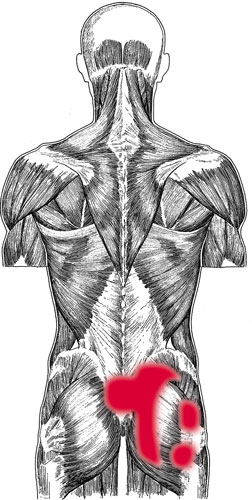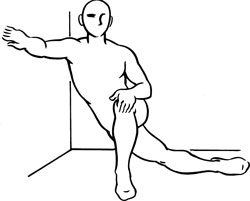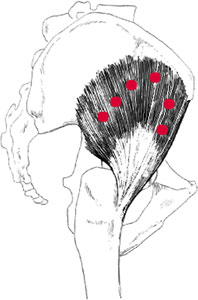Trigger Point Therapy for Myofascial Pain (27 page)
Read Trigger Point Therapy for Myofascial Pain Online
Authors: L.M.T. L.Ac. Donna Finando

G
LUTEUS
M
EDIUS
Proximal attachment:
Anterior three-quarters of the iliac crest.
Distal attachment:
Greater trochanter of the femur.
Action:
Abduction of the thigh; assists in medial rotation of the thigh. Anterior fibers flex and internally rotate the thigh; posterior fibers extend and externally rotate the thigh. Stabilizes the pelvis during ambulation.
Palpation:
The posterior portion of this muscle lies deep to gluteus maximus; the anterior portion lies anterior to gluteus maximus and is superficial. Portions of this muscle lie both anterior and posterior to the hip joint. Gluteus medius is a frequently overlooked source of back pain.
To locate gluteus medius, identify the following structures:
- Iliac crestâLying on a horizontal line with the junction of L4âL5.
- Greater trochanterâBony prominence on the lateral aspect of the femur, approximately one hand-length below the iliac crest. From the anterior plane the greater trochanter lies horizontal with the pubic crest.
- Anterior superior iliac spine (ASIS)âAnterior bony projection lying somewhat below the iliac crest, readily palpable. The ASIS serves as the proximal attachment for the inguinal ligament.
- Piriformis lineâAn imaginary line drawn from the second sacral segment (just medial to the posterior superior iliac spine [PSIS]) to the upper border of the greater trochanter. This line represents the superior border of the piriformis muscle and the posterior border of the gluteus medius muscle.
Palpate gluteus medius with the patient positioned either prone or side-lying. Palpate with flat digital pressure just distal to the iliac crest, following its course on either side of the hip joint. Areas of constriction of gluteus medius can be palpated throughout the course of the external ilium.

Gluteus medius pain pattern
Pain pattern:
Medial trigger points refer pain to the crest of the ilium, the sacroiliac joint, and the sacrum. Lateral trigger points refer pain to the buttock and possibly the upper lateral posterior thigh. Anterior trigger points may refer bilaterally over the sacrum and the lower lumbar region. Symptoms include pain when walking, when lying on the back or on the affected side, and when sitting slouched in a chair.
Causative or perpetuating factors:
Overuse injuries; sudden overload; chronic overload due to prolonged flexion of the hip; leg-length discrepancies; sacroiliac joint dysfunction.
Satellite trigger points:
Quadratus lumborum, gluteus minimus, piriformis, tensor fasciae latae.
Affected organ system:
Genitourinary system.
Associated zones, meridians, and points:
Lateral zone; Foot Shao Yang Gall Bladder meridian; GB 29 and 30.
Stretch exercises:
- Cross the affected leg behind the unaffected leg, shifting your weight toward the affected hip. Reach both arms above the head, grasping the wrist of the homolateral arm with the opposite hand. Laterally bend the torso toward the unaffected side. Hold this position for a count of ten to fifteen.
- Support your balance by holding on to a wall or table. Cross the affected leg behind the unaffected leg. Bend the knee of the unaffected leg as you slide the affected leg away from the torso, toward the opposite side, aiming the hip for the floor. Hold this position for a count of ten to fifteen.
Strengthening exercise:
Positioned on the hands and knees, shift your weight onto one knee, allowing freedom of motion of the working thigh and leg. Keeping the knee of the working leg bent, abduct the leg to bring the inner thigh parallel with the floor. Return the leg to the starting position. Repeat five to ten times.
Walking is one of the best exercises for this muscle.

Stretch exercise 1: Gluteus medius

Stretch exercise 2: Gluteus medius

Gluteus minimus and trigger points
G
LUTEUS
M
INIMUS
Proximal attachment:
On the ilium, between the anterior and inferior gluteal lines, deep to gluteus medius.
Distal attachment:
Upper aspect of the greater trochanter of the femur.
Action:
Abduction of the thigh; internal rotation of the thigh. Stabilizes the pelvis during ambulation.
Palpation:
Gluteus minimus, the smallest of the three gluteal muscles, lies deep to gluteus medius and tensor fasciae latae. The fiber arrangements of gluteus medius and gluteus minimus are quite similar; consequently, their actions, stretches, and strengthening exercises are very much the same.
To locate gluteus miminus, identify the following structures:
- Iliac crestâLying on a horizontal line with the junction of L4âL5.
- Anterior superior iliac spine (ASIS)âAnterior bony projection lying somewhat below the iliac crest, readily palpable. The ASIS serves as the proximal attachment of the inguinal ligament.
- Gluteus mediusâSee muscle description on page 157.
- Tensor fasciae lataeâSee muscle description on page 165.
- Piriformis lineâAn imaginary line drawn from the second sacral segment (just medial to the posterior superior iliac spine [PSIS]) to the upper border of the greater trochanter. This line represents the superior border of the piriformis muscle and the lower posterior border of the gluteus medius muscle.
To locate the anterior fibers of gluteus minimus, begin with the patient lying in the supine position. Palpate just distal and lateral to the ASIS, palpating deeply both anterior to and posterior to the tensor fasciae latae. Taut bands of constricted muscle lying deep to the superficial musculature may be encountered with deep palpation.
To locate the posterior fibers of gluteus minimus, begin with the patient lying prone. Taut bands of constricted muscle may be palpated deep to the gluteus medius just superior and lateral to the midpoint of the piriformis line. Although palpating deeply, it is essential to use caution to avoid causing undue pain to the patient or injury to the superficial musculature.

Gluteus minimus (lateral) pain pattern

Gluteus minimus (posterior) pain pattern
Pain pattern:
Anterior trigger points refer pain to the lower lateral part of the buttock, the lateral aspect of the thigh and knee, and the lateral aspect of the leg as far as the ankle; posterior trigger points refer to the buttock, the posterior thigh and calf, and sometimes to the back of the knee. Symptoms include hip pain that may cause a limp during walking; pain while lying on the same side; pain upon rising from a chair; pain while standing straight or standing still. The pain pattern displayed by this muscle when it harbors trigger points closely resembles what is commonly referred to as sciatica.
Causative or perpetuating factors:
Sudden, acute, or chronic repetitive over-load; sacroiliac joint dysfunction; gait distor-tion; leg-length discrepancies.
Satellite trigger points:
Piriformis, gluteus medius, vastus lateralis, quadratus lumborum, gluteus maximus.
Affected organ system:
Genitourinary system.
Associated zones, meridians, and points:
Lateral zone; Foot Shao Yang Gall Bladder meridian; GB 29 and 30.
Stretch exercises:
- Cross the affected leg behind the unaffected leg, shifting your weight toward the affected hip. Reach both arms above the head, grasping the wrist of the homolateral arm with the opposite hand. Laterally bend the torso toward the unaffected side. Hold this position for a count of ten to fifteen.
- Support your balance by holding onto a wall or table. Cross the affected leg behind the unaffected leg. Bend the knee of the unaffected leg as you slide the affected leg away from the torso, toward the opposite side, aiming the hip for the floor. Hold this position for a count of ten to fifteen.
Strengthening exercise:
Positioned on the hands and knees, shift your weight onto one knee, allowing freedom of motion of the working thigh and leg. Keeping the knee of the working leg bent, abduct the leg to bring the inner thigh parallel with the floor. Return the leg to the starting position. Repeat five to ten times.